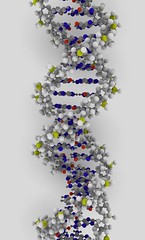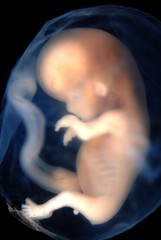AP psych: Developmental psychology Flashcards
Terms : Hide Images [1]
| 5285067933 | Behavior genetics | The study of the relative power and limits of genetic and environmental influences on behavior |  | 0 |
| 5285067935 | environment | Every nongenetic influence, from prenatal nutrition to the people and things around us |  | 1 |
| 5285067937 | chromosomes | Threadlike structures made of DNA molecules that contain the genes |  | 2 |
| 5285067939 | DNA | A complex molecule containing the genetic information that makes up the chromosomes |  | 3 |
| 5285067941 | genes | The biochemical units of heredity that make up the chromosomes |  | 4 |
| 5285067944 | genome | The complete instructions for making an organism |  | 5 |
| 5285067947 | Identical twins | Twins who develop from a single fertilized egg that splits in two |  | 6 |
| 5285067950 | Fraternal twins | Twins who develop from separate fertilized eggs |  | 7 |
| 5285067953 | temperament | A person's characteristic emotional reactivity and intensity | 8 | |
| 5285067955 | heritability | proportion of variation among individuals that we can attribute to genes |  | 9 |
| 5285067959 | interaction | Occurs when the effect of one factor depends on another factor | 10 | |
| 5285067961 | Molecular genetics | Subfield of biology that studies the molecular structure and function of genes |  | 11 |
| 5285067963 | Evolutionary psychology | Study of the evolution of behavior and the mind using natural selection |  | 12 |
| 5285067965 | Natural selection | Principle that among range of inherited trait variations, those that lead to increased reproduction and survival will most likely be passed on to succeeding generations |  | 13 |
| 5285067967 | mutation | Random error in gene replication that leads to a change |  | 14 |
| 5285067969 | gender | Biologically and socially influenced characteristics by which people define male and female |  | 15 |
| 5285067971 | culture | The enduring behaviors, ideas, attitudes, values, and traditions shared by a group of people and transmitted from one generation to the next |  | 16 |
| 5285067973 | norm | An understood rule for accepted and expected behavior |  | 17 |
| 5285067976 | Personal space | The buffer zone we like to maintain around our bodies |  | 18 |
| 5285067978 | individualism | Giving priority to one's own goals over group goals and defining one's identity in terms of personal attributes rather than group identifications |  | 19 |
| 5285067980 | collectivism | Giving priority to the goals of one's group which often one's extended family or work group |  | 20 |
| 5285067984 | aggression | Physical or verbal behavior intended to hurt someone |  | 21 |
| 5285067986 | X chromosome | Sex chromosome found in both men and women | 22 | |
| 5285067989 | Y chromosome | Sex chromosome found only in males | 23 | |
| 5285067993 | testosterone | Most important of the male sex hormones |  | 24 |
| 5285067995 | role | Set of expectations about a social position |  | 25 |
| 5285067999 | Gender role | Set of expected behaviors for males and for females |  | 26 |
| 5285068001 | Gender identity | One's sense of being male or female |  | 27 |
| 5285068003 | Gender typing | Acquisition of a traditional masculine or feminine role |  | 28 |
| 5285068005 | Social learning theory | The theory that we learn social behavior by observing and imitating and by being rewarded or punished |  | 29 |
| 5285166417 | zygotes | The fertilized egg Enters a 2 week period of rapid cell division and develops into an embryo |  | 30 |
| 5285166418 | embryo | The developing human organism from about 2 weeks after fertilization through the 2nd month |  | 31 |
| 5285166422 | fetus | Developing human organism from 9 weeks after conception to birth |  | 32 |
| 5285166424 | teratogens | Agents, such as chemicals and viruses, that can reach the embryo or fetus during prenatal development and cause harm |  | 33 |
| 5285166426 | Fetal alcohol syndrome | Physical and cognitive abnormalities in children caused by a pregnant woman's heavy drinking |  | 34 |
| 5285166428 | Rooting reflex | Baby's tendency, when touched on the cheek, to turn toward the touch, open the mouth, and search for the nipple |  | 35 |
| 5285166430 | maturation | Biological growth process that enable orderly changes in behavior |  | 36 |
| 5285166432 | schemas | A concept or framework that organizes and interprets information |  | 37 |
| 5285166434 | assimilate | Interpreting one's new experience in terms of one's existing schemas |  | 38 |
| 5285166436 | accommodate | Adapting one's current understandings to incorporate new information |  | 39 |
| 5285166438 | cognition | All the mental activities associated with thinking, knowing, remembering, and communicating |  | 40 |
| 5285166440 | Sensorimotor stage | The stage during which infants know the world mostly in terms of their sensory impressions and motor activities in Piaget's theory from birth to about 2 years |  | 41 |
| 5285166444 | Preoperational stage | The stage during which a child learns to use language but does not yet comprehend the mental operations of concrete logic in Piaget's theory from about 2 to 6 or 7 years old |  | 42 |
| 5285166446 | conservation | The principle that properties such as mass, volume, and number remain the same despite changes in the forms of object |  | 43 |
| 5285166451 | Theory of mind | People's ideas about their own and others' mental states | 44 | |
| 5285166454 | Concrete operational stage | The stage of cognitive development during which children gain the mental operations that enable them to think logically about concrete events in Piaget's theory from 6 to 11 |  | 45 |
| 5285166456 | Formal operational stage | The stage of cognitive development during which people begin to think logically about abstract concepts in Piaget's theory beginning at the age of 12 |  | 46 |
| 5285166458 | Stranger anxiety | Fear of strangers that infants commonly display, beginning by about 8 months |  | 47 |
| 5285166460 | attachment | Emotional tie with another person, shown in young children by their seeking closeness to the caregiver and showing distress on separation | 48 | |
| 5285166462 | Critical period | Optimal period shortly after birth when an organism's exposure to certain stimuli or experiences produces proper development | 49 | |
| 5285166464 | imprinting | Process by which certain animals form attachments during a critical period very early in life |  | 50 |
| 5285166466 | Basic trust | According to Erik Erikson, a sense that the world is predictable and trustworthy, said to be formed during infancy by appropriate experiences with responsive caregivers |  | 51 |
| 5285166468 | self-concept | A sense of one's identity and personal worth |  | 52 |
| 5285166470 | adolescence | Transition period from childhood to adulthood, extending from puberty to independence |  | 53 |
| 5285166472 | puberty | Period of sexual maturation where a person becomes capable of reproducing | 54 | |
| 5285166474 | Primary sex characteristics | Body structures that make sexual reproduction possible | 55 | |
| 5285166476 | Secondary sex characteristics | Nonreproductive sexual characteristics | 56 | |
| 5285166478 | menarche | First menstrual period | 57 | |
| 5285166479 | Trust vs. mistrust | Erikerison's stage: Infancy (to 1) If needs are dependably met, infants develop a sense of basic trust | 58 | |
| 5285166484 | Autonomy vs. shame/doubt | Erikerison's stage: Toddlerhood (1-2) Toddlers learn to exercise will and do things for themselves, or they doubt their abilities | 59 | |
| 5285166487 | Initiative vs. guilt | Erikerison's stage: Preschooler (3-5) Preschoolers learn to initiate tasks and carry out plans, or they feel guilty about efforts to be independent | 60 | |
| 5285166490 | industry vs. inferiority | Erikerison's stage: Elementary (6-puberty) Children learn the pleasure of applying themselves to tasks, or they feel inferior | 61 | |
| 5285166493 | Identity vs. role confusion | Erikerison's stage: Adolescence (teens-20s) Teenagers work at refining a sense of self by testing roles and then integrating them to form a single identity, or they become confused about who they are | 62 | |
| 5285166496 | Intimacy vs. isolation | Erikerison's stage: Young adult (20s-40s) Young adults struggle to form close relationships and to gain the capacity for intimate love, or they feel socially isolated | 63 | |
| 5285166499 | Generativity vs. stagnation | Erikerison's stage: Middle adulthood (40s-60s) In middle age, people discover a sense of contributing to the world, usually through family and work, or they may feel a lack of purpose | 64 | |
| 5285166502 | Integrity vs. despair | Erikerison's stage: Late adulthood (60s+) When reflecting on his/her life, the older adult may feel a sense of satisfaction or failure | 65 | |
| 5285241306 | identity | One's sense of self Adolescent's task is to solidify a sense of self by testing and integrating various roles | 66 | |
| 5285241309 | intimacy | The ability to form close, loving relationships Primary development task in late adolescence and early adulthood | 67 | |
| 5285241312 | menopause | Time of natural cessation of menstruation | 68 | |
| 5285241314 | Alzheimer's disease | Progressive and irreversible brain disorder characterized by gradual deterioration of memory, reasoning, language, and physical functioning | 69 | |
| 5285241316 | Cross-sectional studies | Study where people of different ages are compared with one another | 70 | |
| 5285241318 | Longitudinal study | Research where same people are restudied and retested over a long period | 71 | |
| 5285241320 | Crystallized intelligence | One's accumulated knowledge and verbal skills Tend to increase with age | 72 | |
| 5285241323 | Fluid intelligence | One's ability to reason speedily and abstractly Tends to decrease during late adult | 73 | |
| 5285241326 | Social clock | Culturally preferred timing of social events such as marriage, parenthood, and retirement | 74 | |
| 5285241328 | Empty-nest syndrome | A feeling of distress focusing on a loss of purpose and relationship | 75 | |
| 5285262451 | nature versus nutrutre | extent to which heredity and the environment each influences behavior | 76 | |
| 5285266734 | continuity versus discontinuity | whether development is gradual, cumulative change from conception to death or a sequence of distinct stages | 77 | |
| 5285271574 | stability versus change | whether or not personality traits present during infancy endure throughout the life span | 78 | |
| 5285289379 | cohort-sequential study | cross-sectional groups are assessed at least two times over a span of months or years, rather than just once | 79 | |
| 5285299734 | prenatal development | begins with fertilizations or conception, and ends with birth | 80 | |
| 5285323007 | neonates | newborn babies | 81 | |
| 5285328367 | sucking | automatic response of drawing in anything at the mouth | 82 | |
| 5285330658 | swallowing | contraction of throat muscles that enables food to pass into the esophagus | 83 | |
| 5285334222 | grasping reflex | when the infant closes his or her fingers tightly around an object put in his or her hand | 84 | |
| 5285338140 | startle reflex | also called moro which a loud noise or sudden drop causes the neonate to automatically arch his/her limbs out, and quickly retract them | 85 | |
| 5285343662 | habituation | decreasing responsiveness with repeated presentation of the same stimulus | 86 | |
| 5285355528 | schema | mental representations that organize and categorize information processed by our brain | 87 | |
| 5285367587 | object permanence | that objects continue to exist even when out of signt | 88 | |
| 5285377012 | preoperational stage | language develops with the ability to think (2-7) | 89 | |
| 5285380596 | egocentric | seeing the world from his or her own point of view | 90 | |
| 5285383473 | animism | that all things living just like him or her | 91 | |
| 5285385615 | artificalism | all objects are made by people | 92 | |
| 5285413618 | internalization | absorbing information from a specified social enviornmental context | 93 | |
| 5285418870 | zone of proximal development | range between the level at which a child can solve a problem working alone with difficulty and the level at which a child can solve a problem with the assistance of adults or more-skilled children | 94 | |
| 5285437512 | preconventional | stage where they do the right thing to avoid punishment or to further their self-interests | 95 | |
| 5285446339 | conventional | stage where they follow rules to live up to the expectations of others or to maintain the law and order and do their duty | 96 | |
| 5285452352 | postconventional | stage where they evidence a social contract orientation that promotes the society's welfare or evidence an ethical principle orientation that promotes justice and avoids self- condemnation | 97 | |
| 5285459015 | social development | influence of others on the development of a person | 98 | |
| 5285465025 | self-awareness | consciousness of oneself as a person | 99 | |
| 5285467361 | social referenceing | observing the behavior of others in social situations to obtain information or guidance | 100 | |
| 5285471789 | authoritarian parents | set up strict rules, expect children to follow them, and punish wrongdoing | 101 | |
| 5285475713 | authoritative parents | set limits but explain the reasons for rules with their children and make exceptions when appropriate | 102 | |
| 5285479316 | permissive parents | tend not to set firm guidelines if they set any at all. more responsive than demanding | 103 | |
| 5285484074 | uninvolved parents | few demands, show low responsiveness and communicate little with their children | 104 | |
| 5285494825 | biological persepective | difference between the sexes to heredity | 105 | |
| 5285496749 | evolutionary perspective | perscpective that focuses on our behavioral tendencies to prepare us to survive and reproduce | 106 | |
| 5285500194 | psychoanalytic persepctive | the perspective that focuses on how young girls learn to act feminine from their mothers, and young boys learn to act masculine from their fathers | 107 | |
| 5285503816 | cognitive perspective | children actively engage in making meaning out of information they learn about gender | 108 | |
| 5285507834 | gender role stereotypes | broad categories that reflect our impressions and beliefs about males and females | 109 | |
| 5285511141 | androgyny | presence of desirable masculine and feminine characteristics in the same individual | 110 | |
| 5285514812 | stereotype threat | anxiety that influences members of a group concerned that their performance will confirm a negative sterotype | 111 |
